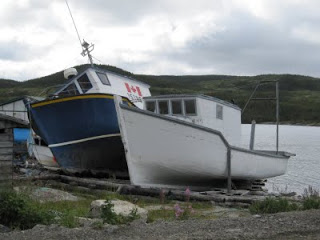 Now, by the time you read this, it might have changed, but when we blundered into our Labrador part of the trip with essentially no maps and just the word of friends met on the road, it was the case that the main highway across Labrador, 500, was not connected to the rest of the roads down along the southern coastline on the St. Lawrence Seaway. A road was being built, but it wasn’t open yet. The only way to get there, was to take a ferry from Goose Bay out across Lake Melville, through the straits at Rigolet and into the Atlantic to reach Cartwright. From there, more gravel highways cut down across the peninsula to reach the towns on the St. Lawrence.
Now, by the time you read this, it might have changed, but when we blundered into our Labrador part of the trip with essentially no maps and just the word of friends met on the road, it was the case that the main highway across Labrador, 500, was not connected to the rest of the roads down along the southern coastline on the St. Lawrence Seaway. A road was being built, but it wasn’t open yet. The only way to get there, was to take a ferry from Goose Bay out across Lake Melville, through the straits at Rigolet and into the Atlantic to reach Cartwright. From there, more gravel highways cut down across the peninsula to reach the towns on the St. Lawrence. It was a wonderful ferry ride on the Sir Robert Bond for me, starting on Sunday afternoon. Lake Melville was smooth and protected and the photographers were out in force taking sunset and rainbow pictures. I noticed a number of summer cabins? down at the water line on islands that we passed. Most were pre-fab buildings that could have been hauled out on a barge or sledded over once the lake froze. Passing through left me many puzzles I’d love to take the time to solve.
It was a wonderful ferry ride on the Sir Robert Bond for me, starting on Sunday afternoon. Lake Melville was smooth and protected and the photographers were out in force taking sunset and rainbow pictures. I noticed a number of summer cabins? down at the water line on islands that we passed. Most were pre-fab buildings that could have been hauled out on a barge or sledded over once the lake froze. Passing through left me many puzzles I’d love to take the time to solve.
 Morning came, after I gave up on the upper bunk and slept on one of the airline-like seats inside. We unloaded at Cartwright along with many other travelers, some of which were in a hurry to make the day long drive down to Blanc-Sablon to catch the next ferry over to Nova Scotia. We took our time, stopping to let Mary Ann take a few pictures of the fishing villages and lighthouses along this lesser-traveled part of the St. Lawrence.
Morning came, after I gave up on the upper bunk and slept on one of the airline-like seats inside. We unloaded at Cartwright along with many other travelers, some of which were in a hurry to make the day long drive down to Blanc-Sablon to catch the next ferry over to Nova Scotia. We took our time, stopping to let Mary Ann take a few pictures of the fishing villages and lighthouses along this lesser-traveled part of the St. Lawrence.  We spent the night in striking distance of the ferry and took some time the next day to sneak down the coast on the Quebec side past Blanc-Sablon. The terrain was fascinating, with solid rock landscapes and the waterfalls, err… chutes d’eau, that pass over them.
We spent the night in striking distance of the ferry and took some time the next day to sneak down the coast on the Quebec side past Blanc-Sablon. The terrain was fascinating, with solid rock landscapes and the waterfalls, err… chutes d’eau, that pass over them.